Named for Professor E. D. Bergmann, an internationally recognized organic chemist, the award honors Bergmann for his pivotal role in establishing the United States-Israel Binational Science Foundation (BSF) and his service on its Board of Governors until his death in 1975. One of his special interests was the encouragement of young scientists. To honor his memory, in 1976 the Board of Governors established a special grant of $5,000 in his name that is awarded annually to promising young scientists. Candidates for the Prof. Bergmann Memorial Award are researchers of exceptional merit who are newly awarded BSF grants and who meet the Bergmann criteria of being no more than 35 years old and having received a doctoral degree within the past ten years.
The BSF awarded four Bergmann Memorial Awards in 2014. While their research foci dramatically differ from one scientist to the next, what they share is a deep curiosity, a passion for their work and an enthusiasm for scientific research. Meet Elana Zion Golumbic, Eyal Privman, Inon Scharf and Jonathan Pruitt.

AWARD WINNER STUDIES COCKTAIL PARTIES
Imagine you are surrounded by friends and colleagues at a fun and exciting party. You hear people around you talking, glasses clinking, and a sports game on a big screen television. What happens in your mind that allows you to instantly choose to join the conversation about a friend’s recent trip to Cuba? Called the Cocktail Party Problem, this is what intrigues Elana Zion Golumbic, Senior Lecturer in the Gonda Brain Research Center, Bar Ilan University. As a cognitive neuroscientist she enjoys bridging the world of the physical and biological sciences with cognition.
A recent recipient of the Bergmann Memorial Award, Zion Golumbic related, “This represents important recognition of my work. I look to the BSF as a good platform to continue significant relationships with colleagues in the United States and to solidify those relationships for the future.” She shared that few granting agencies emphasis collaboration between scientists, “The award funds are helpful — I have used the award to purchase a virtual reality system to simulate real life for my research volunteers — but from my perspective the big benefit of the BSF is the ability to sustain professional relationships”
As listeners, we pick up important auditory cues and clues while we are deeply engaged in a conversation, and while a distraction might occur across the room, we might not be aware of it as we are receiving information from many sources. Our ear functions as a microphone, but it cannot separate out conversations on its own. Zion Golumbic studies how the brain is able to distinguish between the inputs from different speakers and to turn up the volume on one conversation while ignoring another. “Airplane pilots are an example for ‘attentional experts’, who excel in concentrating on one thing while scanning many other inputs at the same time,” related Zion Golumbic. “Yet, many in our society find this difficult, such as the aging population with hearing loss, or those faced with the challenges of ADHD.” Her work has real world applications as she explains, “As we better understand our behavior within the Cocktail Party setting, we can train people to gain control and be better attenders.”
Zion Golumbic is fortunate that at Bar Ilan University she has access to cutting edge technology to help measure the brain’s function. Bar Ilan has the only magnetoencephalography machine, or MEG for short, in Israel. With it, she can record signals more accurately and pinpoint what is happening within the brain. Although also not readily available in the United States, both her colleague David Poeppel, Professor of Psychology and Neural Science in the New York University Department of Psychology and she use the MEG in their research.
Said Poeppel, “Elana came to New York and worked with Charlie Schroeder (of Columbia University and the Nathan Kline Institute) and me. She was the post-doc of one’s dreams! Elana took up ideas that Charlie and I had developed – independently and largely disconnected – and she linked them and turned them into theoretically well motivated, technically cutting edge, and just plain clever experiments that we had not thought of. We generated several papers together, bridging insights from animal physiology, human cognitive neuroscience, experimental psychology, and language research. She made fundamental progress using two highly complex brain recording techniques, the MEG and Electrocorticography (ECoG), on how the brain rhythms that “entrain” to spoken input, say a conversation, are represented in the human brain, and how attending to one or the other event, say one speaker in a conversation, can be selected and amplified by attention. Her work on attention and its role in exploiting brain rhythms provides some critical new insights about how certain brain mechanisms form the basis for complex cognition, such as the interplay between language comprehension and attention.”
Also from Bar Ilan University is noted mathematician and Professor Mina Teicher, a long time BSF Board of Governors member, “The Bergmann Memorial Award evolved over the years into a very prestigious award,” said Teicher. “I am very glad that one of the Israel award winners in 2014 was Elana Zion Golumbic. Elana is a rising star in neuroscience. Following her postdoctoral position, she returned to Israel to a prestigious position in the Gonda Brain Research Center in Bar Ilan University. Her work in perception and representation in the brain is truly interdisciplinary and crosses borders. One of her topics is the “Cocktail Party Problem”– how the brain eliminates background noise and allows a conversation in a noisy environment. I trust she and her BSF partner from the United States will contribute to the most challenging question in the 21st century – How does the brain work?”
Zion Golumbic’s day is taken up with writing, teaching, mentoring students, interaction with research subjects and laboratory work. With a husband who is a Jewish educator and Rabbi and raising three young daughters, she is excited by this phase in her life. Finding balance is always a challenge as she goes between her family and her growing laboratory.
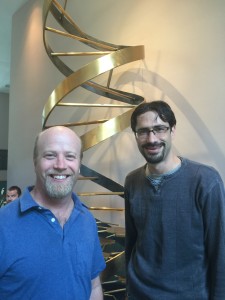
Pictured are DeWayne Shoemaker with Eyal Privman
AWARD WINNER STUDIES FIRE ANTS – INVADERS AND MUTANTS
The United States-Israel Binational Science Foundation (BSF) funded collaborative research between Eyal Privman, Assistant Professor, Institute of Evolution, Department of Evolutionary and Environmental Biology, University of Haifa and DeWayne Shoemaker, a researcher entomologist at the United States Department of Agriculture-Agricultural Research Service, Center for Medical, Agricultural, and Veterinary Entomology in Gainesville, FL. Together they are studying the social biology and genomics of fire ants. “The fire ant is a horrible pest,” said Privman. “Millions of dollars are lost by the agricultural industry in damage each year. “
“I was honored to be among the Bergmann Memorial Award winners in 2014,” related Privman. “I’m investing the award receipts into personnel for the laboratory. It will help fund a graduate student who will work with me on analyzing the ants’ genomic sequences.”
Privman acknowledges that this prestigious award is good for his career. As a young researcher, the Bergmann award acknowledges his achievements and he is delighted to have been recognized.
Privman and Shoemaker are studying two different species of fire ants, one red and one black, that are now found in the United States and the phenomenon that these two species hybridize in the USA. They also are using cutting edge techniques to study and compare the genomes and physical traits of fire ants from the United States and from their native ranges in South America. This will help them understand how fire ants adapt to novel environments and how social behavior evolves.
“I do this because I have a scientific interest in understanding things in the world around me,” said Privman when pressed why his is involved in scientific research. “I’m interested in fire ants as social insects, how their genes determine how they evolve and change and the implications for their social structure. In 2010, I switched from studying microbes to fire ants and began to look at the genetic basis for differences in their social behavior. For instance, I was interested in how the workers that are all daughters of the queen work equally hard for the good of the nest. I then looked at a colony that had two queens and observed the workers wondering if there would be a difference in how these daughters worked together. In both cases all the ants put the needs of the colony ahead of their personal interests. I found that fire ants are fascinating organisms in which to study how social behavior evolves. Since then I am analyzing their genomes, looking for the genes responsible for their sociality.”
Privman’s partner DeWayne Shoemaker specializes in population genetics and has built a huge collection of ant samples. Privman uses computational methods to analyze the sequence of the ant’s genome. Said Shoemaker, “I met Eyal when he was a postdoctoral researcher in Switzerland. While visiting the lab, I quickly became aware that he and I had common interests. However one difference, which is a strength of our collaboration, is that while I am a trained evolutionary biologist and entomologist, Eyal has strong computational biology skills. Thus, our interests are similar but our skills are a great combination for a collaborative relationship because we both bring different skills and viewpoints to the project. Success of this project relies on extensive bioinformatics and Eyal is really a perfect fit. Not just anyone can do these analyses. They require someone with his unique expertise.”
Shoemaker continued, “Our project is about understanding how new species arise and how species adapt to changing or novel environments. Fire ants are an excellent model for these questions because of their stunning success as invaders and the well-documented genetic and ecological changes that have taken place in the invasive populations. Two different species were introduced into the USA last century from their native South America. Interestingly, the two species hybridize in the USA but not in their native range, which provides an ideal scenario for trying to understand the genetics of species differences. Our studies will provide unprecedented empirical evidence to test theoretical models and to reveal the molecular mechanisms of reproductive isolation and adaptation. Also, our studies will reveal key adaptive genes in invasive ant populations, potentially lead to new insights into the biology of ant invasions as well as more general understanding of social biology and evolution.”
SPIDERS, ANT LIONS AND WORM LIONS – THEIR STRESS TEACHES US ABOUT OUR STRESS
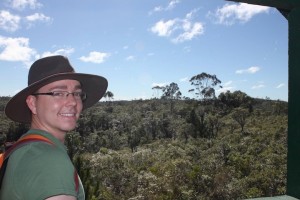
Jonathan Pruitt
“Why spiders? I always get asked that question,” related Jonathan Pruitt, Assistant Professor, Department of Biological Sciences, University of Pittsburgh of his work with arachnids. “But frankly, more of them fit into a drawer than, let’s say, a Gorilla.” Pruitt talks a mile a minute and is obviously passionate about his work. He and his research collaborator Inon Scharf, Senior Lecturer, Department of Zoology, Tel Aviv University were both Bergmann Memorial Award winners in 2014.
Scharf calls his research partner very talented. They met at a conference in Germany and soon learned that they both were interested in personalities in animals. “We both work with invertebrates that build traps,” said Scharf. “I study worm lions and ant lions. Both of these species dig pits in the sand and wait for their prey to step in. I chose these insects because they are easy to grow and compare, they have a unique hunting behavior, and it’s easy to collect and keep them in the lab. Insects in general are great animal models for research. You can collect them in really high numbers and it’s easy to obtain approvals to use them for research. People often forget that insects are the largest taxonomic group of animals but not as often studied as vertebrates and it is therefore important to understand them better”.
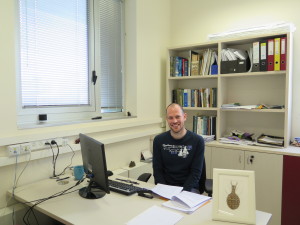
Inon Scharf
Their United States-Israel Binational Science Foundation (BSF) funded grant involves studying the insects and how stress relates to their development and personality. “With my research,” explained Pruitt, “personality traits are unique to each animal and to each type of breed. Consider how different your pet beagle is from your pet golden retriever. Stress in the wild influences if the animal lives or dies, if it can acquire resources and territory. Stressors over time define the animal’s personality. I’m interested in the evolutionary origins of stress. I study spiders because a lot is already known about them. It’s relatively easy to control an experiment to learn about something specific, like disease, weather, food and the like, and conduct that same experiment with little variations over and over again.”
 Scharf is interested in learning if the unique personality types observed in the insect will last the lifetime of the insect through the metamorphosis stages of larva, pupa and the adult. He observes that insects do display unique personality traits but strives to understand if these traits correlate with their behavior through life. For instance if an insect is active and moving a lot, would it also be aggressive? Or, will an insect that displays a fear of predators when a larva have that some fear as an adult?
Scharf is interested in learning if the unique personality types observed in the insect will last the lifetime of the insect through the metamorphosis stages of larva, pupa and the adult. He observes that insects do display unique personality traits but strives to understand if these traits correlate with their behavior through life. For instance if an insect is active and moving a lot, would it also be aggressive? Or, will an insect that displays a fear of predators when a larva have that some fear as an adult?
Pruitt relates that stress is a major problem for us all. If we deal with stress well or poorly, their work has real world applications as the research will help us better understand how humans deal with stress.
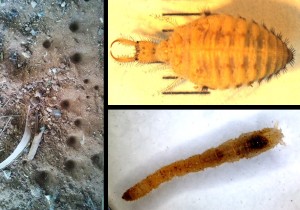 Their Bergmann Memorial Awards added both additional financial resources and prestige. Said Pruitt, “It helps when the university considers promotions and tenure. With the award proceeds, I plan to attend top tier conferences to share our work in international venues.” Said Scharf, “This award for young researchers is very important. The prize money will help me expand my research in the personalities of insect groups – ant colonies – in addition to individual insects. Being recognized with the Bergmann Award helps my reputation and shows that I’m competitive in my field. This is even more important than the money. What I love about the BSF is it’s emphasis on getting scientists together.” Pruitt concurred, “I like the BSF’s emphasis on collaboration. Most funding agencies don’t stress that aspect. Collaboration creates a cross fertilization synergy.”
Their Bergmann Memorial Awards added both additional financial resources and prestige. Said Pruitt, “It helps when the university considers promotions and tenure. With the award proceeds, I plan to attend top tier conferences to share our work in international venues.” Said Scharf, “This award for young researchers is very important. The prize money will help me expand my research in the personalities of insect groups – ant colonies – in addition to individual insects. Being recognized with the Bergmann Award helps my reputation and shows that I’m competitive in my field. This is even more important than the money. What I love about the BSF is it’s emphasis on getting scientists together.” Pruitt concurred, “I like the BSF’s emphasis on collaboration. Most funding agencies don’t stress that aspect. Collaboration creates a cross fertilization synergy.”
Looking forward to his visit to Israel later in the year, Pruitt said, “It is a tiny country yet contains four to five top tier world class universities. There is such a high concentration of researchers, it’s like a society of scientists. I’m excited to meet researchers during my trip, to learn about their cutting edge research and share the work Scharf and I are accomplishing.”
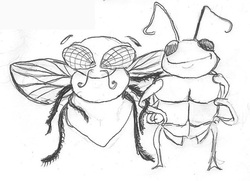 Pruitt typically spends about a third of his year in Africa studying spiders in Savanna trees in the Kalahari Desert region. This is a childhood dream come true, as he had wished to travel and work far away from his home.
Pruitt typically spends about a third of his year in Africa studying spiders in Savanna trees in the Kalahari Desert region. This is a childhood dream come true, as he had wished to travel and work far away from his home.
Both Pruitt and Scharf continue with their hobbies even with the pull of their laboratories, teaching and home life. Scharf likes music and history and playing his flute. If you don’t find him working out in the gym to relax, you’ll find him baking. Pruitt’s outside activities are equally eclectic. He collects snow globes, plays the steel drums and copes with his own stress by running 6 to 9 miles a day. He even mentors young students in middle school through high school by training teachers to teach science. He travels to local schools and demonstrates how to conduct scientific experiments using his spiders. “I hope that I’m instilling in those young people the belief that they too can become a researcher, that they can go into the sciences and become a scientist,” said Pruitt.

